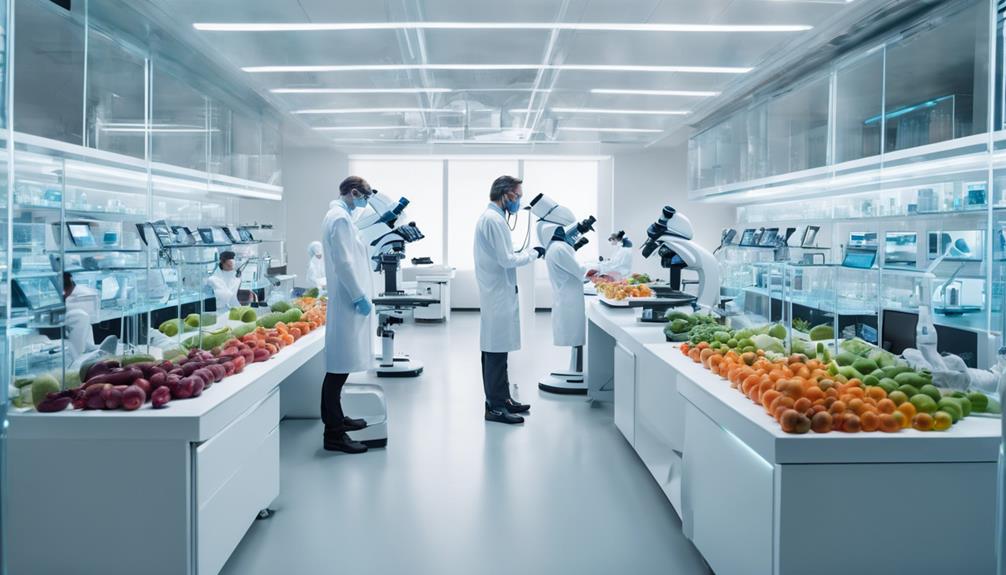The Amazing Biotech Trends In Food Safety

Biotech Trends In Food Safety are changing how you guarantee the safety of what you eat. Rapid testing methods allow for quick detection of contaminants, giving you confidence in food quality. Genetically engineered crops boost pest resistance and improve nutritional value, supporting healthier choices. CRISPR technology helps identify harmful pathogens faster, while microbiome research enhances safety protocols. Blockchain technology guarantees transparency in the food supply chain, so you can trace your food’s journey. As consumer awareness grows, you’re becoming more informed about safe food practices. Stay curious to discover how these trends continue to evolve and impact your food safety.
Advances in Rapid Testing
When it comes to food safety, advances in rapid testing are revolutionizing how we detect contaminants. You might be surprised at how quickly technology is evolving, enabling you to identify pathogens in food samples with remarkable speed and accuracy. Point of care testing is one of the most exciting developments in this field, allowing you to conduct tests right where you need them, rather than sending samples off to a lab.
Imagine being able to test your food for harmful pathogens within minutes. Traditional methods often take days, putting your health and safety at risk while you wait for results. With rapid testing, you can guarantee that the food you’re consuming is safe, reducing the likelihood of foodborne illnesses. This is especially vital in environments like restaurants, food processing plants, and even your own kitchen.
The technology behind pathogen detection has improved considerably, incorporating innovative biosensors and molecular techniques. These advancements not only enhance the sensitivity and specificity of tests but also make them easier to use. You don’t need a Ph.D. in microbiology to understand how to operate these tools. Many point of care devices are designed for ease of use, making them accessible for everyone.
As you embrace these rapid testing solutions, you’ll find greater confidence in the food you prepare and serve. The shift toward faster, more reliable methods of pathogen detection is a game changer, paving the way for safer food practices and ultimately, better health outcomes for all.
Genetically Engineered Crops
Genetically engineered crops are changing the landscape of food safety by enhancing pest resistance and improving nutritional profiles. You might wonder how these innovations meet regulatory safety standards and what that means for the food you consume. Let’s explore the implications of these advancements on your health and the environment.
Enhanced Pest Resistance
Many farmers are turning to enhanced pest resistance through genetically engineered crops to combat the growing threats posed by pests and diseases. By utilizing advanced pest resistance mechanisms, you can greatly reduce crop losses and the need for chemical pesticides. This not only helps protect your yields but also supports sustainable agriculture practices that are essential for long-term food security.
Genetically engineered crops often incorporate genes from naturally pest-resistant plants or bacteria. These modifications create traits that deter pests, making your crops less appealing to them. For instance, certain crops produce proteins that are toxic to specific insects, drastically reducing the chances of infestations.
In addition to boosting your crops’ resilience, these methods can lead to reduced environmental impact. By relying less on chemical pesticides, you’re promoting healthier soil and water resources. Moreover, enhanced pest resistance can contribute to higher yields, making it easier to feed a growing population while minimizing the land needed for agriculture.
Embracing these innovations can revolutionize how you approach farming, ensuring that your practices are both effective and environmentally responsible. With enhanced pest resistance, you’re not just growing crops; you’re cultivating a sustainable future.
Nutritional Profile Improvements
As you investigate the world of genetically engineered crops, you’ll find that nutritional profile improvements are becoming a key focus in food production. Farmers and scientists are leveraging innovative approaches to enhance the nutritional value of staple crops through nutritional enhancement. By using biofortification strategies, they’re able to increase essential vitamins and minerals in crops that are already widely consumed.
For instance, crops like Golden Rice have been engineered to contain higher levels of vitamin A, addressing deficiencies that affect millions globally. This kind of targeted enhancement not only improves the health of individuals but also supports public health initiatives in regions where malnutrition is prevalent.
Moreover, other crops are being modified to provide increased iron, zinc, or protein content. These advancements have the potential to transform diets and help combat various nutritional deficiencies.
As you investigate deeper into these developments, you’ll see how genetic engineering is not just about yield and pest resistance but also about making food healthier and more nutritious. The future of food production is bright, with the promise of healthier options right around the corner.
Regulatory Safety Standards
With the growing focus on nutritional improvements in food production, understanding the regulatory safety standards for genetically engineered crops becomes vital. You need to grasp how regulatory compliance works to guarantee that these crops are safe for consumption. Regulatory agencies play a significant role in this process, conducting thorough risk assessments and safety audits to evaluate the potential impacts of genetically engineered organisms.
As you navigate through policy development, you’ll notice that international standards guide many countries in establishing their own regulations. These standards help create a consistent framework for certification processes, making sure that genetically engineered crops meet safety benchmarks before entering the market.
Enforcement mechanisms are essential, too. They guarantee that producers adhere to these regulations, maintaining the integrity of the food supply. By familiarizing yourself with these safety standards, you’ll better understand the checks and balances in place that protect consumers. This knowledge not only supports informed decisions but also fosters confidence in the advancements of biotechnology in food safety. Embracing these standards is key to sustaining public trust and promoting the benefits of genetically engineered crops in addressing global food challenges.
CRISPR Technology Applications
In the domain of food safety, CRISPR technology offers groundbreaking applications that enhance our ability to detect and eliminate foodborne pathogens. By utilizing gene editing, you can develop rapid diagnostic tests that identify harmful bacteria like Salmonella or E. coli with unprecedented accuracy. This means you can verify your food products are safe before they reach consumers, reducing the risk of foodborne illnesses.
Moreover, CRISPR allows for the modification of crops to make them more resistant to pests and diseases. Imagine growing tomatoes that can withstand blight or potatoes that are less susceptible to rot. This not only boosts food security but also minimizes the need for chemical pesticides, promoting a safer food supply chain.
However, as exciting as these advancements are, they bring CRISPR ethics to the forefront of discussions. You might wonder about the implications of gene editing in agriculture and food production. Striking a balance between innovation and ethical considerations is significant. It’s important to engage in open dialogues about how these technologies can be applied responsibly, guaranteeing they benefit society without causing unforeseen consequences.
Microbiome Research in Safety
Understanding the microbiome’s role in food safety is vital for enhancing overall health. You’ll discover how innovations in detection methods can help identify harmful pathogens more effectively. This research could redefine how we approach food safety in the future.
Microbiome’s Role in Safety
The microbiome plays an essential role in food safety by influencing both the detection of pathogens and the overall health of food systems. Microbiome diversity is significant, as it helps maintain balanced microbial ecosystems that can outcompete foodborne pathogens. This diverse community interacts with pathogens, reducing their ability to thrive and potentially causing illness.
Understanding these pathogen interactions is critical for developing effective safety protocols. For instance, microbial metabolites produced during fermentation processes can inhibit harmful bacteria, contributing to gut health and overall food safety. By leveraging these biotic factors, you can enhance the resilience of food systems against contamination.
Monitoring microbiota dynamics allows for early detection of shifts that may indicate potential safety risks. By analyzing changes in microbial populations, you can identify emerging threats and respond proactively. In addition, fostering a healthy microbiome in food production can lead to safer products, benefiting consumers.
Incorporating microbiome research into food safety strategies not only protects public health but also promotes sustainable practices. Embracing the complexity of microbial ecosystems can offer innovative solutions to mitigate foodborne illness and promote safer food for everyone.
Innovations in Detection Methods
Leveraging advances in microbiome research, scientists are developing innovative detection methods that enhance food safety. These methods utilize novel biomarkers to identify pathogens more accurately and quickly. By integrating automated systems with predictive analytics, you can detect potential contamination before it becomes a problem.
Digital platforms allow for real-time monitoring of food products, guaranteeing that safety protocols are followed at every stage of production. With sensor integration, you can gather data continuously, offering insights into environmental conditions that may affect food safety.
Artificial intelligence plays a vital role in analyzing this data, helping to predict risks based on historical trends. Data visualization tools make it easier for you to interpret complex datasets, enabling quicker decision-making. Cloud computing guarantees that all this information is accessible from anywhere, allowing for seamless updates and collaboration among stakeholders.
Mobile applications further enhance these innovations, providing users with alerts and updates on food safety in real time. Together, these technologies are revolutionizing food safety detection methods, making the food supply chain safer and more efficient. Embracing these advancements is essential for maintaining high standards in food safety.
Blockchain for Traceability
Blockchain technology is revolutionizing traceability in the food supply chain, providing a transparent and secure way to track products from farm to table. By utilizing decentralized ledgers, you can guarantee data integrity at every step of the process. This technology allows for real-time tracking of food items, giving you instant access to information about their journey, from production to consumption.
One of the key benefits of blockchain is its ability to enhance consumer trust. When you know the food provenance and can verify its origin, it fosters confidence in the products you buy. With transparency benefits built into the system, consumers can easily access detailed information about the sourcing and handling of their food. This level of openness not only satisfies consumer demand for accountability but also helps businesses comply with regulatory requirements.
Smart contracts play a significant role in streamlining operations within the supply chain. They automatically execute agreements based on pre-set conditions, reducing the risk of fraud and errors. By integrating traceability solutions powered by blockchain, companies can improve efficiency while guaranteeing compliance with safety standards.
Sensor Technologies in Monitoring
Sensor technologies are increasingly vital in monitoring food safety throughout the supply chain. By employing advanced sensors, you can track environmental conditions such as temperature, humidity, and contamination levels in real-time. This capability allows you to guarantee that food products remain safe from farm to table.
With sensor integration, you can streamline data collection and analysis across various stages of production and distribution. Imagine having sensors embedded in storage units, transportation vehicles, and even packaging. These devices can communicate and send alerts if conditions deviate from safety standards, enabling you to take immediate action. This proactive approach greatly reduces the risk of foodborne illnesses.
Real-time analytics plays a key role in this monitoring process. Instead of waiting for periodic checks, you receive continuous data that helps identify potential hazards before they become serious issues. For instance, if a temperature sensor detects a rise in heat in a refrigerated truck, you can quickly adjust the conditions or reroute the shipment to maintain safety.
Moreover, the integration of sensor technologies with big data systems allows you to analyze trends and patterns over time. This information can guide your decision-making, helping you improve food safety protocols and respond to potential threats more effectively. In a world where consumer trust is paramount, leveraging sensor technologies guarantees you stay ahead of food safety challenges, safeguarding both your products and your reputation.
Food Safety Regulations and Biotech
Steering through the complex landscape of food safety regulations is essential for any biotech company involved in the food industry. You’ll quickly find that maneuvering compliance challenges can be intimidating, especially when it comes to food labeling and guaranteeing your products meet all necessary standards. Each country has its own set of regulations, which can vary considerably, and keeping up with these can feel overwhelming.
In the U.S., for instance, the FDA and USDA have specific guidelines that dictate how food products should be labeled, particularly when biotech methods are involved. You need to make sure that your labeling clearly communicates the use of biotechnology in your products, as this transparency is essential for compliance. Missteps in this area can lead to costly penalties and can damage your company’s reputation.
Moreover, understanding the regulatory framework surrounding genetically modified organisms (GMOs) is imperative. Many consumers are concerned about GMOs, and regulations are tightening. As a biotech company, you must stay ahead of any changes in legislation to avoid compliance challenges that could arise from new requirements.
To mitigate risks, consider investing in regulatory consultants who specialize in food safety. These experts can help you navigate the complexities of food labeling and ensure that your products are compliant with all regulations. By staying informed and proactive, you can effectively manage the intricacies of food safety regulations and focus on providing safe, innovative food solutions.
Consumer Awareness and Education
Consumer awareness around food safety and biotechnology is more important than ever. As a consumer, you face a myriad of choices and challenges, especially with the rise of biotechnology in food production. Awareness campaigns play a vital role in educating you about the benefits and safety of biotechnologically enhanced foods. These campaigns aim to clarify misconceptions, enabling you to make informed choices.
However, misinformation challenges persist. Social media and other platforms often spread false information that can skew public perceptions of biotech foods. It’s imperative to seek reliable sources and stay updated on current research to combat this misinformation.
Labeling transparency is another significant aspect of consumer education. You deserve clear information about what’s in your food and how it’s produced. Transparent labeling helps you understand whether a product includes biotech ingredients, allowing you to make choices that align with your values and preferences.
As you navigate the grocery store aisles, remember that being informed empowers you. Engaging with reputable organizations and participating in awareness campaigns can enhance your understanding of food safety and biotechnology. By advocating for transparency and holding companies accountable, you contribute to a more knowledgeable consumer landscape. Ultimately, it’s about ensuring that you have the tools to make informed decisions that affect your health and well-being. Embrace the journey of learning, and don’t hesitate to ask questions—after all, an informed consumer is a powerful one.
Biotech Trends In Food Safety; Frequently Asked Questions
How Does Biotechnology Impact Food Safety Employment Opportunities?
Biotechnology’s advancements create exciting opportunities for you in food safety careers. As biotech job growth accelerates, you’ll find increased demand for skilled professionals, allowing you to contribute to safer food systems and innovative solutions.
What Role Do Consumers Play in Biotech Food Safety Innovations?
Consumers play a crucial role in biotech food safety innovations. Your awareness drives demand for safer products, while your regulatory influence encourages companies to adhere to safety standards, ensuring a healthier food supply for everyone.
Are There Ethical Concerns Related to Biotech in Food Safety?
You might worry about ethical concerns surrounding genetic modification and its potential impact on health. It’s essential to understand regulatory frameworks that govern these technologies, ensuring safety and addressing public concerns while promoting innovation in food safety.
How Can Small Farms Utilize Biotech for Food Safety?
You can leverage biotech applications by adopting small scale innovations like improved pest resistance and soil health management. These methods enhance food safety, reduce chemical use, and promote sustainability, benefiting both your farm and the environment.
What Are the Costs Associated With Adopting Biotech Safety Measures?
When considering biotech safety measures, you’ll need to conduct a cost analysis. Factor in the initial investment implications, ongoing maintenance costs, and potential savings from reduced risks to determine if it’s worth your resources.
Conclusion
In summary, staying informed about biotech trends in food safety is essential for you as a consumer. Advances in rapid testing, CRISPR technology, and blockchain for traceability are reshaping how food safety is managed. By understanding these innovations, you can make better choices and advocate for stronger regulations. As the industry evolves, your awareness and education will play a key role in ensuring the safety and quality of the food you consume.








